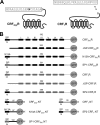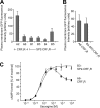The pseudo signal peptide of the corticotropin-releasing factor receptor type 2a decreases receptor expression and prevents Gi-mediated inhibition of adenylyl cyclase activity
- PMID: 20682782
- PMCID: PMC2963340
- DOI: 10.1074/jbc.M110.129627
The pseudo signal peptide of the corticotropin-releasing factor receptor type 2a decreases receptor expression and prevents Gi-mediated inhibition of adenylyl cyclase activity
Abstract
The corticotropin-releasing factor receptor type 2a (CRF(2(a))R) belongs to the family of G protein-coupled receptors. The receptor possesses an N-terminal pseudo signal peptide that is unable to mediate targeting of the nascent chain to the endoplasmic reticulum membrane during early receptor biogenesis. The pseudo signal peptide remains uncleaved and consequently forms an additional hydrophobic receptor domain with unknown function that is unique within the large G protein-coupled receptor protein family. Here, we have analyzed the functional significance of this domain in comparison with the conventional signal peptide of the homologous corticotropin-releasing factor receptor type 1 (CRF(1)R). We show that the presence of the pseudo signal peptide leads to a very low cell surface receptor expression of the CRF(2(a))R in comparison with the CRF(1)R. Moreover, whereas the presence of the pseudo signal peptide did not affect coupling to the G(s) protein, G(i)-mediated inhibition of adenylyl cyclase activity was abolished. The properties mediated by the pseudo signal peptide were entirely transferable to the CRF(1)R in signal peptide exchange experiments. Taken together, our results show that signal peptides do not only influence early protein biogenesis. In the case of the corticotropin-releasing factor receptor subtypes, the use of conventional and pseudo signal peptides have an unexpected influence on signal transduction.
Figures








Similar articles
-
The Pseudo signal peptide of the corticotropin-releasing factor receptor type 2A prevents receptor oligomerization.J Biol Chem. 2012 Aug 3;287(32):27265-74. doi: 10.1074/jbc.M112.360594. Epub 2012 Jun 11. J Biol Chem. 2012. PMID: 22689579 Free PMC article.
-
The corticotropin-releasing factor receptor type 2a contains an N-terminal pseudo signal peptide.J Biol Chem. 2006 Aug 25;281(34):24910-21. doi: 10.1074/jbc.M601554200. Epub 2006 Jun 8. J Biol Chem. 2006. PMID: 16766521
-
Evidence that corticotropin-releasing factor receptor type 1 couples to Gs- and Gi-proteins through different conformations of its J-domain.Br J Pharmacol. 2006 Dec;149(7):942-7. doi: 10.1038/sj.bjp.0706926. Epub 2006 Oct 23. Br J Pharmacol. 2006. PMID: 17057757 Free PMC article.
-
Functional Significance of the Signal Peptides of Corticotropin-Releasing Factor Receptors.Curr Mol Pharmacol. 2017;10(4):311-317. doi: 10.2174/1874467210666170224094915. Curr Mol Pharmacol. 2017. PMID: 28240192 Review.
-
Corticotropin releasing factor receptors and their ligand family.Ann N Y Acad Sci. 1999 Oct 20;885:312-28. doi: 10.1111/j.1749-6632.1999.tb08687.x. Ann N Y Acad Sci. 1999. PMID: 10816663 Review.
Cited by
-
Type 1 Corticotropin-Releasing Factor Receptor Differentially Modulates Neurotransmitter Levels in the Nucleus Accumbens of Juvenile versus Adult Rats.Int J Mol Sci. 2022 Sep 16;23(18):10800. doi: 10.3390/ijms231810800. Int J Mol Sci. 2022. PMID: 36142716 Free PMC article.
-
The putative signal peptide of glucagon-like peptide-1 receptor is not required for receptor synthesis but promotes receptor expression.Biosci Rep. 2014 Nov 21;34(6):e00152. doi: 10.1042/BSR20140120. Biosci Rep. 2014. PMID: 25330813 Free PMC article.
-
Actin cytoskeleton-dependent regulation of corticotropin-releasing factor receptor heteromers.Mol Biol Cell. 2017 Sep 1;28(18):2386-2399. doi: 10.1091/mbc.E16-11-0778. Epub 2017 Jul 12. Mol Biol Cell. 2017. PMID: 28701349 Free PMC article.
-
Misfolding Ectodomain Mutations of the Lutropin Receptor Increase Efficacy of Hormone Stimulation.Mol Endocrinol. 2016 Jan;30(1):62-76. doi: 10.1210/me.2015-1205. Epub 2015 Nov 10. Mol Endocrinol. 2016. PMID: 26554443 Free PMC article.
-
Dopamine D1 and corticotrophin-releasing hormone type-2α receptors assemble into functionally interacting complexes in living cells.Br J Pharmacol. 2014 Dec;171(24):5650-64. doi: 10.1111/bph.12868. Br J Pharmacol. 2014. PMID: 25073922 Free PMC article.
References
Publication types
MeSH terms
Substances
LinkOut - more resources
Full Text Sources
Molecular Biology Databases

